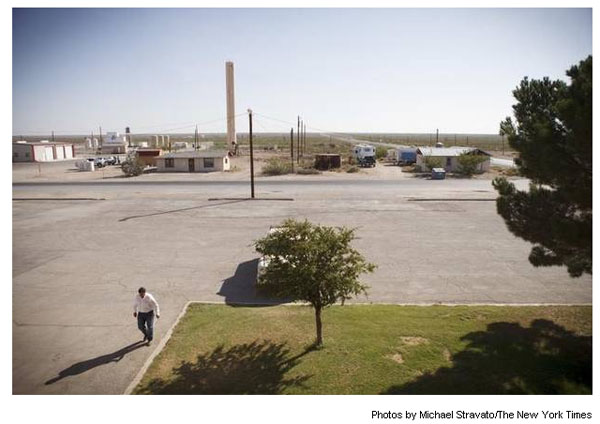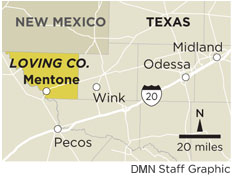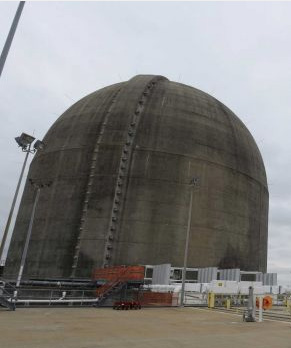Archive for the ‘Toxic Waste Dump’ Category
Loving County to feds: Send us your nuclear waste — and $28 billion

Skeet Jones, a Loving County judge, walks to the courthouse in Mentone. He backs locating a toxic waste storage facility in the county because of the money it would generate.
Published: 07 August 2014 08:01 PM
Updated: 07 August 2014 08:06 PM
Matthew L. Wald,
The New York Times
MENTONE — Loving County is big, dry and stretches for miles, and is the perfect place, local officials say, to store high-level radioactive waste.
Officials here hope to entice the federal government — with $28 billion to spend on the disposal of high-level radioactive waste — into considering the possibility.
"With the money that this would generate for the county, we might even be able to pay the taxpayers back," said the county judge, Skeet Jones. "We could build some roads. We could bring in some more water. We could have a town that’s incorporated, have a city council, maybe even start a school." Loving County had a school, but it has been boarded up for years, and students are bused to neighboring Winkler County.
"Maybe even have a Wal-Mart," Jones mused.
 About midway between El Paso and Midland-Odessa, Loving County, population 95, according to the Census Bureau, is spread across 650 square miles. Mentone, the county seat, has a courthouse, a single gas station, a food truck and not much else.
About midway between El Paso and Midland-Odessa, Loving County, population 95, according to the Census Bureau, is spread across 650 square miles. Mentone, the county seat, has a courthouse, a single gas station, a food truck and not much else.
"There are no lawyers, no bank, no hospital, no real estate agency, nothing," said Mozelle Carr, the county clerk. Carr is Jones’ sister.
The family, which makes up about a quarter of the voters in the county, is not unanimous in its support of a storage site. Their father, Elgin R. Jones, who goes by Punk and was sheriff from 1965 to 1992, said he foresaw trouble in anything radioactive. But he admits being in the minority.
The cancellation of the federal government’s plan to bury high-level radioactive waste at Yucca Mountain in Nevada means that the waste will remain at about 70 reactor sites around the country until there is some other plan. Loving County has visions of storing spent fuel from closed reactors in aboveground casks, and later, building a processing plant that would recover unused uranium, and plutonium for reuse, making the rest easier to bury. County officials are working with a company that is hoping to negotiate a deal with the state and federal governments. Two counties just across the state line in New Mexico are also seeking to become storage sites.
Any plan would probably require federal legislation, because the nuclear waste fund is supposed to be used for disposal, not storage. But Congress has an incentive; the Treasury is facing billions of dollars in damage claims because of the Energy Department’s delay.
Storing spent fuel in a central location, in preparation for burial or for reprocessing, looks more attractive as defunct reactors from Maine to California are torn down, and as reactor owners sue the Energy Department, which was supposed to begin accepting the waste for burial in 1998, to recover their costs.
"Interim" storage, though, would mean adding a cumbersome job: shipping the fuel a second time, for burial. Or maybe not. "If we let this waste into Texas, it’s likely never to be shipped anywhere else, because nobody really wants it," said Tom Smith, an energy advocate at Public Citizen in Austin.
Two lawyers in Austin, Monty G. Humble and Bill Jones, raised the idea with Gov. Rick Perry, who Humble said was "not opposed," and then went shopping for a county that would be interested. They argued that two counties in New Mexico, Eddy and Lea, were another possibility, and that if the waste were taken there that the New Mexico counties would get all the benefit but Loving would get some of the risk.
Humble, who specializes in energy topics, and Bill Jones, who was Perry’s first general counsel, formed a company, Advanced Fuel Cycle Initiatives, and have been negotiating with a landowner in the county. The county has designated the two as its agents in Austin, and the two are seeking the same designation from the state of Texas in order to negotiate with the Department of Energy over terms of a lease, including research grants to Texas universities, new roads and emergency equipment for towns in the area.
Perry has ordered a state study of the storage idea. "I believe it is time for Texas to act," he wrote in a letter in March, partly because New Mexico was considering a site within 50 miles of the Texas border.
While some Texas officials oppose the idea of a high-level storage site, some also see it as inevitable. "It’s going to be Texas," said Lon Burnam, a state representative from the Dallas area. "Everyone else is too smart to take it." Burnam fought hard against a low-level waste burial site, which is in Andrews, but was unsuccessful.
In Loving, Raymond Wildman, the cashier at Hopper Station, a gas station and convenience store that is also the county’s only retail outlet, offered another reason that could make a West Texas site attractive. Given the low population, he said, "We wouldn’t be missed if something happened."
This document contains copyrighted material whose use has not been specifically authorized by the copyright owner. SEED Coalition is making this article available in our efforts to advance understanding of ecological sustainability, human rights, economic democracy and social justice issues. We believe that this constitutes a "fair use" of the copyrighted material as provided for in section 107 of the US Copyright Law. If you wish to use this copyrighted material for purposes of your own that go beyond "fair use", you must obtain permission from the copyright owner.
Concerns aplenty on nuclear waste
MAY 30, 2014
San Antonio Express-News Editorial Board

This is the South Texas Project electric generating station near Bay City. The state is now examining the possibility of creating a high-level nuclear waste dump. The idea raises environmental concerns. Photo: Express-News File Photo / San Antonio Express-NewsPhoto By Express-News file photo This is the South Texas Project electric generating station near Bay City. The state is now examining the possibility of creating a high-level nuclear waste dump. The idea raises environmental concerns.
SAN ANTONIO — Gov. Rick Perry is pushing for a high-level radioactive waste facility. And state Speaker Joe Straus has asked a House committee to wrestle with the issue of creating such a facility — perhaps in West Texas.
There are perfectly legitimate concerns attached; each one must be satisfactorily answered. If they can’t be, Texas simply shouldn’t allow such a facility.
Can it be safely stored?
We’re not talking about low-level radioactive waste, a site for which Texas already has. High-level radioactive waste generally involves spent nuclear rods, potentially deadly even with brief exposure. Safety must be as ironclad a guarantee as is technologically possible given the life of this waste — thousands of years. No corners should be cut.
Can it be safely transported?
Accidents and human error happen, and when they do, they will potentially affect even more people during waste transport than at a facility at a remote site. But a site in West Texas — which is widely viewed as the likely location if one is built — likely means transporting waste on Interstate 10, right through San Antonio and other population centers. Ditto, if by rail. The industry contends that casks developed for transport are safe. The committee must test that.
Can the waste be stored as effectively where it is produced?
In Texas, this would be at each of the state’s four nuclear plants.
Environmentalists credibly argue that dry cask storage at nuclear plants cuts out the middle-man — transportation. If this is the case, why create a large site with a lot of waste? To endanger only one part of the state rather than four?
Will safety or economic impact be the trumping factor?
It should be safety.
Environmentalists fear that Straus’ charge to the committee involves looking only at the economic impact of a facility. Such a site will likely be privately operated like the existing low-level site in Andrews County, run by Dallas-based Waste Control Specialists.
If this site is expanded or another picked, this means needed jobs and tax revenue. Environmental issues will be considered, the Speaker’s Office said.
"This charge was referred to the Committee on Environmental Regulation so they can conduct a thorough review for possible nuclear storage and will hear from all stakeholders to ensure that environmental, economic and regulatory issues are considered," according to a statement provided to the Editorial Board.
Will the decision be based on need or on the clout of political heavyweights?
There is the need. Like it or not, the state has four nuclear plants. These produce waste. If we use the power, we have to live and deal with the waste also generated.
But it’s been widely noted that Harold Simmons, the late owner of Waste Control Specialists, gave Perry roughly $3 million — some going to Perry’s campaign committee, other amounts to the Republican Governors Association when the governor was raising money for it.
Perry has been pushing for this high-level radioactive waste site. Part of the task for Straus’ committee is to determine whose need is being served here.
Will this be for Texas-only waste or will it take other states’ waste as well?
The federal government has botched identification and creation of a national repository. The Obama administration has given up on Yucca Mountain in Nevada. And a federal court in November, noting the disarray on this issue, told the feds they could no longer collect fees from utilities for waste storage since there is no federal facility.
States have formed compacts with other states for storage of low-level waste.
So, is Texas or a private entity operating a state site maneuvering for the state to become a national repository? And if not, are they positioning themselves to take other states’ waste?
The answer has to be "no" to both but particularly on the first proposition.
Straus’ committee should consider these and all other pertinent factors.
This document contains copyrighted material whose use has not been specifically authorized by the copyright owner. SEED Coalition is making this article available in our efforts to advance understanding of ecological sustainability, human rights, economic democracy and social justice issues. We believe that this constitutes a "fair use" of the copyrighted material as provided for in section 107 of the US Copyright Law. If you wish to use this copyrighted material for purposes of your own that go beyond "fair use", you must obtain permission from the copyright owner.
Hearing on Implementing the Nuclear Waste Policy Act
Hearing on “Implementing the Nuclear Waste Policy Act – Next Steps,” Subcommittee on Environment and the Economy (September 10, 2013)
Nuclear Power and Radioactive Waste Environment and Energy
Subcommittee on Environment and the Economy (113th Congress)
Sep 10, 2013
2123 Rayburn House Office Building
The Subcommittee on Environment and the Economy held a hearing on Tuesday, September 10, 2013, at 10:00 a.m. in 2123 Rayburn House Office Building. The hearing was titled, “Implementing the Nuclear Waste Policy Act – Next Steps.”
New Mexico nuclear waste site halts shipments of toxic materials to Texas
May 10, 2014
By Laura Zuckerman
Reuters
(Reuters) – A New Mexico nuclear waste dump, which saw a radiation leak in February, has halted shipments of toxic waste barrels to a commercial Texas facility amid concerns that chemical reactions could trigger another release there, officials said on Friday.
A probe found the February 14 accident may have been linked to improperly prepared and packaged drums of toxic waste accepted from the Los Alamos National Laboratory by the Waste Isolation Pilot Plant (WIPP), its managers said in a statement.
Investigators are still evaluating whether a chemical reaction caused the leak of unsafe concentrations of radiation in the underground salt caverns where waste is stored, which exposed 21 workers above ground to low levels of contamination.
"As they evaluate this possibility, it is prudent to temporarily stop shipments of this specific (Los Alamos lab) waste stream" to a commercial storage facility in Texas, managers said.
The WIPP complex in the Chihuahuan Desert in southeastern New Mexico was designed to permanently seal in salt chambers clothing, tools and other materials contaminated with radioisotopes like plutonium from U.S. nuclear labs and weapons sites.
There may have been chemical reactions between nitrate salts in radiological materials and organic materials such as plastic packing in barrels of waste from the Los Alamos lab, Jim Blankenhorn, deputy manager with the contractor running WIPP, told a public meeting on Thursday.
Fifty-five of the suspect barrels were stored in the salt chamber where the accident happened and additional drums from the same waste stream are in a separate disposal area below ground, Blankenhorn said.
Los Alamos chemists are seeking to develop a process for filtering out the nitrate salts before packing and shipping containers of waste, he said.
The repository is not expected to resume operations for at least 18 months but it may take as long as three years to be fully operational, Blankenhorn said.
(Reporting by Laura Zuckerman in Salmon, Idaho; Editing by Eric M. Johnson and Clarence Fernandez)
This document contains copyrighted material whose use has not been specifically authorized by the copyright owner. SEED Coalition is making this article available in our efforts to advance understanding of ecological sustainability, human rights, economic democracy and social justice issues. We believe that this constitutes a "fair use" of the copyrighted material as provided for in section 107 of the US Copyright Law. If you wish to use this copyrighted material for purposes of your own that go beyond "fair use", you must obtain permission from the copyright owner.
LANL waste shipments suspended
CCNS NEWS UPDATE
Runs 5/9/14 through 5/16/14
(THEME UP AND UNDER) This is the CCNS News Update, an overview of the latest nuclear safety issues, brought to you every week by Concerned Citizens for Nuclear Safety. Here is this week’s top headline:
* LANL waste shipments suspended
On May 2nd, the Department of Energy (DOE) announced that some nuclear waste shipments from Los Alamos National Laboratory (LANL) to Waste Control Specialists (WCS) were suspended for an undetermined amount of time. The reason for the stoppage was that one or more LANL waste containers may have exploded underground and caused the February 14th radiation release from the Waste Isolation Pilot Plant (WIPP). However, DOE continues to state that the cause of the radiation release is unknown, but that it is investigating all possible scenarios.
Neither DOE nor LANL publicly identified the specific group of containers, called a waste stream, that are included in the shipment suspension. Nor have they publicly stated how many of the suspect containers are at WIPP and WCS and how many remain at LANL.
The suspended waste stream is LA-MIN02-V.001, which is the source of 54 of the 268 contact-handled waste containers in room 7, panel 7, at WIPP, where the radiation release may have originated. Another 116 containers from that waste stream are now at WCS. The waste stream was created by plutonium operations at LANL that are continuing at Technical Area 55.
The containers hold a portion of the 3,706 cubic meters of plutonium-contaminated waste that is the subject of the January 2012 Framework Agreement between the New Mexico Environment Department and LANL. The agreement states that it is non-binding, but LANL committed to removing all of that waste from Area G by June 30th, 2014. http://www.nmenv.state.nm.us/documents/Summary_of_NNMCAB_01-5-2012.pdf
When WIPP was closed in early February, about 100 shipments remained at LANL to meet the June 30th date. Since those shipments could not go to WIPP, DOE agreed to pay WCS $8.8 million to receive and store those wastes for up to one year.
The Environment Department has insisted that LANL meet the June 30th date, but not the deadlines for other cleanup activities included in the Consent Order that require wide-scale cleanup by 2015. Since October 2011,the Environment Department has issued more than 95 extensions of time for LANL to submit groundwater protection and cleanup investigation reports required by the Consent Order. http://www.nmenv.state.nm.us/HWB/documents/LANL_Extensions_as_of_4-7-2014.pdf The Framework Agreement does not give the Environment Department any power to impose fines and penalties to LANL for missing the June 30th deadline, while NMED does have that power under the Consent Order.
Joni Arends, of CCNS, said, "Both LANL and the Environment Department put all of their eggs in one basket by focusing on getting the waste off the Hill to WIPP instead of doing all of the work required under the Consent Order. Now, we still have waste at LANL – with more being created – but many of the important Consent Order activities have not been done."
This has been the CCNS News Update. For more information, please visit http://www.nuclearactive.org and like us on Facebook.
—
Concerned Citizens for Nuclear Safety (CCNS)
P. O. Box 31147
Santa Fe, NM 87594-1147
(505) 986-1973
www.nuclearactive.org


